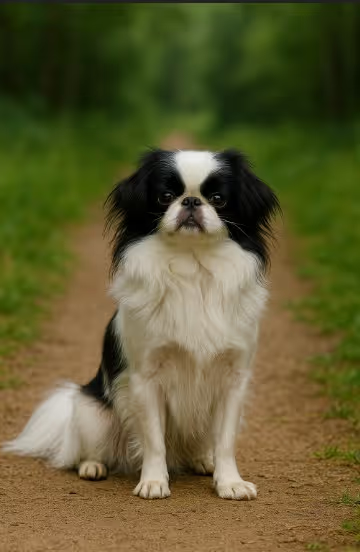The Japanese Chin is a toy breed known for its elegant, cat-like demeanor and affectionate personality. With a distinctive plume tail and a luxurious coat, this charming companion thrives in calm environments and loves nothing more than lounging in their owner’s lap. The breed is prized for its quiet intelligence, gentle temperament, and aristocratic charm.

The Japanese Chin has a mysterious and ancient lineage. Despite its name, the breed likely originated in China and was gifted to the Japanese imperial family over a thousand years ago. There, it became a treasured companion of nobility, often carried in sleeves or displayed in palaces. It wasn’t until the mid-1800s that the breed was introduced to Europe and North America, quickly winning hearts with its refined elegance and expressive eyes.
The Japanese Chin’s appearance is both dainty and regal, with movements that resemble a feline’s grace.
The Japanese Chin’s fine coat requires moderate grooming to stay clean and tangle-free.
Grooming Tips:
The Japanese Chin is a low-energy breed that needs just moderate daily activity.
Exercise Ideas:
They are highly adaptable to apartment living but enjoy brief outdoor outings. Too much activity can overwhelm their delicate frame.
Japanese Chins are intelligent and eager to please but may have an independent streak.
Training Advice:
They thrive with a gentle, consistent training approach in a peaceful household.
This small breed has a delicate digestive system and benefits from a high-quality, easily digestible diet.
Feeding Guidelines:
Watch for signs of dental issues or sensitivities, which are common in toy breeds.
Always look for ethical breeders or rescue organizations familiar with toy breeds.
Resources:
Questions to Ask Breeders:
You may also find Chins available through small breed rescue groups.
Are Japanese Chins hypoallergenic?
No, but they are light shedders and may still be suitable for some allergy sufferers.
Are they good with children?
Yes, when raised with calm, respectful children. Their small size makes them better suited to homes with older kids.
Do Japanese Chins bark a lot?
They are not known to be excessive barkers. They may alert their owners but are generally quiet.
Can they be left alone?
They don’t tolerate long hours alone well and may become anxious. Ideal for someone home frequently.
Is the Japanese Chin a cat-like dog?
Yes! Their movements, independence, and grooming habits have often earned them the nickname “the cat of the dog world.”